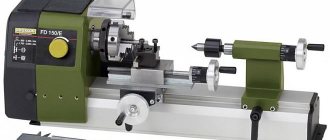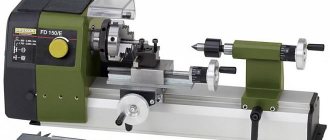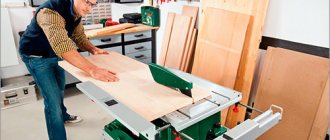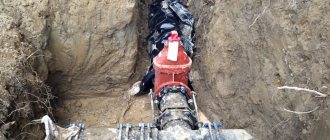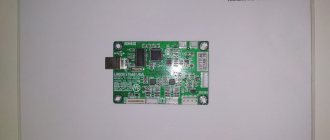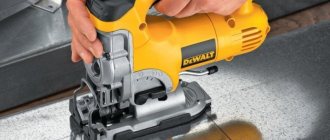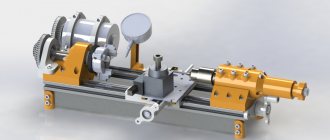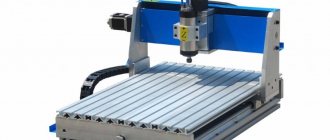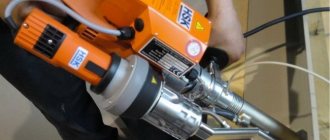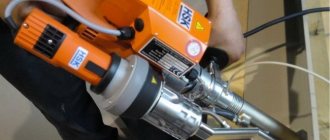Do It Yourself (Knowledge) 2011-03, page 117
KNITTING MACHINE FOR KNITTING NETS, TRADES, ETC.
Structure of a knitting machine
A hand knitting machine consists of 5 main parts.
1) The body of the machine is made of aluminum tube.
2) The shuttle is made of aluminum. There is a slot on the side for thread passage. The shuttle has a 45 degree cut. Inside the shuttle, in the back wall, there is a 2.5 mm conical recess for fixing the bobbin.
3) The bobbin is made of bronze on a lathe. The bobbin moves freely in the shuttle.
4) The shuttle plug is made of aluminum. In the center there is a through hole = 2-3 mm for fixing the second end of the bobbin. The cork is inserted into the shuttle tightly so that it does not fall out during operation.
5) The shuttle travel stop is made of aluminum plate.
Preparing for work
The bobbin with thread is inserted into the shuttle and closed with a stopper. The assembled shuttle is inserted into the body of the machine, with the plug facing forward until it stops. The sharp end of the shuttle is located at the bottom of the machine body. The limiter does not reach the shuttle 2-3 mm. This is necessary for the passage of thread during work. The thread passes through the slot of the shuttle and is tied to the net.
For knitting, a spatula made of any material of the required size per mesh is also used. The thread lies on the shoulder blade. The lower part of the machine fits into the cell. The mesh thread passes under the shuttle and comes out from above the shuttle. Pull it to the shoulder blade and press the thread with your finger. We throw the thread from the shuttle to our left, in a semi-ring, and grab one or two threads of the mesh. The mesh thread also passes around the shuttle and comes out from above. And the thread that we throw from ourselves to the left should pass from the bottom of the machine. Pull, and the knot is ready, without moving the machine in your hands.
You can knit it differently, as you wish. The main thing is that the knot is knitted quickly.
Knitting on a bar
Take a block 1.5-2 m long, with a cross-section of 30×30 mm. A nail is firmly fixed at the beginning of the block. And, retreating 200 mm, we make markings, for example: 36 mm (depending on the mesh size). The distance between the holes should be the same along the entire length of the bar.
The diameter of the holes is 1-3 mm (depending on the nail). Hole depth 20 mm. The nail should fit into the hole freely, but not dangle (Fig. 1). We start the network on a board. Let's tie it like this for about a meter. Then, when you understand the meaning, you can start on the block. A nail is inserted into the first hole. All cells are dialed onto it. And the net is pulled over the “dead” nail and secured. Then we pull out the free nail with the cells on it and insert it into the next hole. The thread is wound around the nail, taken with two fingers, the index and middle, then a flip is made away from you to make a loop (Fig. 2). The loop should be above the cell at the top (Fig. 3). We grab the mesh through the loop and pass the needle through the mesh (Fig. 4). The thread does not let go from your fingers -
Demand analysis and market assessment of chain-link mesh
According to consumption estimates, about 90% of all manufactured mesh is used for arranging fences and other barriers at construction sites, personal gardens and summer cottages, and making enclosures for birds and animals. The remaining 10% is occupied by various needs of construction, agriculture, mechanical engineering, energy (reinforcement during plastering work, sifting crushed rocks and building materials, strengthening slopes from embankments, manufacturing protective screens for ventilation shafts, protecting heating mains and pipelines, etc.).
The price of the mesh and its use depends on the following factors:
- cell sizes;
- material for manufacturing (ferrous, galvanized metal, polymer coatings, stainless steel);
- wire thickness;
- roll sizes.
Before starting production, you should assess the demand for chain-link mesh in your region: take into account the quantity, approximate sales volumes, assortment (and the most popular items) of competitors, analyze existing offers and prices at wholesale construction sites and retail stores.
The main channels for the sale of chain-link mesh (finished products):
1) Independent implementation. The final consumer is individuals.
Pros: ability to set a maximum markup.
Cons: advertising costs, space for a store or showroom, transportation costs (delivery).
2) Retail stores (construction, hardware). Targeted at summer residents, owners of country houses, private construction. The final consumer is individuals.
Pros: when concluding a sales agreement with a chain of retail stores, you can achieve relatively constant sales of products.
Disadvantages: high store markup (about 30%), high competition, small volumes, sales dependent on many unpredictable factors (recommendations of the seller, location of the product on the shelf, attractive appearance);
3) Wholesale centers (companies selling various metal products). Focused on large orders, construction companies, industrial enterprises, retail chains. The end consumer is legal entities of all forms of ownership, private entrepreneurs.
Pros: large volumes, time saving (no need to go shopping, negotiate, sign agreements, etc.).
Cons: high competition, large but irregular, mostly seasonal sales, which can be described in one phrase: “rarely, but accurately.”
4) Direct sales to industrial enterprises (participation in tenders)
Pros: ability to work “to order”, guaranteed level of sales. Products are not stored in the warehouse, they are paid according to the contract, without vague deadlines for implementation.
Cons: for a “newbie” in business, winning a tender on favorable terms is almost impossible.
Of course, in theory, the best option would be to work out all the channels, but in practice, such a volume of work is impossible to accomplish in a short period of time. Therefore, the general recommendation is to start with retail sales, while simultaneously searching for alternative options and developing your own customer base.
Step-by-step instructions on how to knit fishing nets with your own hands and using a machine
From the very beginnings of his existence, man has been obtaining food for himself. As a result, he learned and invented many ways to obtain food, including fishing. Over time, this activity has turned from a necessity into a hobby.
Fish are caught using a fishing rod and various contraptions. A very effective tackle is a net. Here we will look at how fishing nets are knitted manually and using a machine.
It should be noted that this gear did not come to its current form immediately. For a long time, water miners have been improving their fishing devices and have come to a common decision that the net should be made by weaving. The knitting technology for this gear has been clearly proven.
There are two ways to weave fishing nets:
- Manually.
- Mechanically, using a knitting machine.
Weaving fishing nets with your own hands
Initially, the net was woven by hand.
It took a lot of time and required perseverance and concentration. However, with some information and patience, it is quite possible to weave a network yourself at home. An avid fisherman will only enjoy making his own tackle. First, you need to acquire a tool and decide what material the network will be made of. To do this, you can use either nylon thread or fishing line.
The choice of a suitable thread depends on the purpose of the net (what kind of fish it will mainly catch), its parameters (length, height and mesh size) and personal preferences.
The “rag” is used when catching species such as silver carp, bream, and large crucian carp is expected. These representatives of the ichthyofauna can easily damage a fishing line net, but if they get caught in a nylon fishing line, they will become thoroughly entangled in it and will not escape.
It is important to choose the correct thread section. Naturally, the thicker it is, the stronger the network. However, here you need to follow the rule of the golden mean. Tackle that is too thick is very noticeable (especially knots) and scares away fish, while gear that is too thin is easily damaged and does not hold the catch.
Tools and accessories
You will need a knitting shuttle and a template. You can make them yourself. The shuttle is made from a thin piece of aluminum or getinax. The thickness varies between 3-5 mm. One edge of the shuttle is pointed and has a slot in the form of a rod on which the thread will be wound. The other end looks like a bicorne that secures the thread.
The thread is wound as follows: A loop is knitted and put on the rod at the top of the shuttle. Then the thread is pressed under tension to the lower edge, where the double horn prevents it from breaking, and the consumable material is wound, alternately turning the shuttle relative to the plane.
The amount of thread will depend on the length of the shuttle, the height of the rod and the depth of the double horn. As a rule, the dimensions of the shuttle are slightly larger than the size of the knitter's wrist.
The template is often made of plastic. It determines the size of the network cell and plays an important final role, so it must be done accurately and accurately. It is important that its edges are parallel and smooth.
A tourniquet will be useful to secure the beginning of the network, as well as a fixed support. As a rule, this is a gas pipe or battery. A thread is attached to it, from which the height of the net is gained, and then the finished tackle is knitted.
Knitting a knot
The strongest and most immovable knot is performed as follows. A template is brought to the finished loop (the first one knitted by hand), and the shuttle is threaded into it.
Fishing net knitting machine
It takes a long time to weave a net manually, even with a lot of experience and skill. There is also a knitting method using special homemade equipment.
The machine for making fishing nets is made of five parts:
- Housing – made of aluminum tube;
- Shuttle - has a cut at an angle of 45 0 and a hole on the side for moving the thread (on the back wall there is a cone-shaped recess of 2.5 mm in which the bobbin is attached);
- A bobbin is a bronze product turned on a lathe, which moves freely in a shuttle;
- Aluminum plug - designed to fix the end of the bobbin (it is inserted tightly into the shuttle and should not fall out during knitting);
- Shuttle movement limiter
Preparatory actions
The thread is wound onto the bobbin and inserted into the shuttle. Then it is closed with a stopper. Assemble the shuttle and install it, with the plug facing forward, into the machine body until it stops. The gap between the stopper and the hook is approximately 3 mm. The thread will pass through it while knitting.
Knitting nets
The mesh size of the future network is determined by the shuttle on which the thread is wound.
The cell includes the lower area of the machine. The thread enters under the shuttle and comes out from above.
Pressing the thread with your finger, pull it to the template and throw it in a half ring to the left. Then grab a couple of cells so that the thread passes from the bottom of the machine, and tighten the knot.
Each master can use his own technique or try different options. The most important thing here is that knots are knitted on a machine much faster than by hand. Happy fishing!
Antique tools for knitting fishing nets
One of the first tools for knitting fishing nets was an ordinary bone needle, which was widely used in the economy of the primitive population. The size of the mesh was most likely determined by the number of fingers on which the craftsman wound the threads. Ancient literature mentions “two-finger” and “three-finger” networks. Knitting nets with bone needles survives into the 20th century.
Over time, specialized tools appear. For a fixed mesh size of the network, they began to use a special wooden plank - a template
(
polútsa
,
polichka
).
An ordinary needle has been transformed into a figured shuttle needle
(
mite
). Templates and shuttle needles are found during archaeological excavations of medieval settlements, the cultural layer of which preserves organic matter. These tools are still used today.
Quite often, these tools are enough, and the master sets up in any place where it is convenient to hold the thread taut and where the net fabric can be neatly folded.
In the north-west of the forest zone of Eastern Europe, additional devices for knitting nets are common, the general name for which is net-knitting spinning wheels. Such a spinning wheel is a wooden board, to one part of which a bent wooden branch with a forked end is attached. There are also spinning wheels made from a single piece of wood.
Different population groups also have their own names for such devices - kozyulya
,
Kozavka
(Russians),
verkkopuu -
a tree for a net,
archipu -
a wooden bull (Izhora, Vod).
The device used by Karelians is somewhat different in design. The board, by analogy with the classic spinning wheel, is called bottom
, a forked branch is
a fork
, and a rod is attached to it for winding the finished fabric -
a shaft
.
When knitting nets, they usually use threads rolled into a ball or wound on a spool. But it happens that special reels are also used.
Such devices are used not only in the manufacture of fishing nets, they are widely used as an auxiliary device for knitting, spinning, embroidery, etc.
Most of the net-knitting tools invented in time immemorial, despite all the progress, successfully survive to this day.
Well, for many indigenous peoples, whose economic activity for many centuries was closely connected with fishing, the ability to knit nets is considered an integral part of traditional culture.
DO THE NETWORKS YOURSELF! DRAWINGS OF A HAND MACHINE FOR KNITTING NETS
A hand knitting machine consists of five main parts.
1) The body of the machine is made of aluminum tube.
2) Chelny. ok made of aluminum. There is a slot on the side for thread passage. The shuttle has a 45 degree cut. Inside the shuttle, in the back wall, there is a 2.5 mm conical recess for fixing the bobbin.
3) The bobbin is made of bronze on a lathe. The bobbin moves freely in the shuttle.
4) The shuttle plug is made of aluminum. In the center there is a through hole d=2-3 mm for fixing the second end of the bobbin. The cork is inserted into the shuttle tightly so that it does not fall out during operation.
5) The shuttle stroke limiter is made of an aluminum plate.
PREPARATION FOR WORK
The bobbin with thread is inserted into the shuttle and closed with a stopper. The assembled shuttle is inserted into the body of the machine, with the plug facing forward until it stops. The sharp end of the shuttle is located at the bottom of the machine body. The limiter does not reach the shuttle 2-3 mm. This is necessary for the passage of thread during work. The thread passes through the slot of the shuttle and is tied to the net.
For knitting, a spatula made of any material of the required size per mesh is also used. The thread lies on the shoulder blade. The lower part of the machine fits into the cell. The mesh thread passes under the shuttle and comes out from above the shuttle. Pull it to the shoulder blade and press the thread with your finger. We throw the thread from the shuttle to our left, in a semi-ring, and grab one or two threads of the mesh. The mesh thread also passes around the shuttle and comes out from above. And the thread that we throw from ourselves to the left should pass from the bottom of the machine. Pull, and the knot is ready, without moving the machine in your hands.
You can knit it differently, as you wish. The main thing is that the knot is knitted quickly.
We take a block 1.5-2 m long, with a cross section of 30X30 mm. A nail is firmly fixed at the beginning of the block. And, retreating 200 mm, we make markings, for example: 36 mm (depending on the mesh size). The distance between the holes should be the same along the entire length of the bar.
The diameter of the holes is 1-3 mm (depending on the nail). Hole depth 20 mm. The nail should fit into the hole freely, but not dangle (Fig. 1). We start the network on a board. Let's tie it like this for about a meter. Then, when you understand the meaning, you can start on the block. A nail is inserted into the first hole. All cells are dialed onto it. And the net is pulled over the “dead” nail and secured. Then we pull out the free nail with the cells on it and insert it into the next hole. The thread is wound around the nail, taken with two fingers, the index and middle, then a flip is made away from you to make a loop (Fig. 2). The loop should be above the cell at the top (Fig. 3). We grab the mesh through the loop and pass the needle through the mesh (Fig. 4). The thread is not released from the fingers, but tension is applied towards itself, there should be an overlap (Fig. 5).
The overlap should be over the hole that is in front of the nail. Press the overlap with your index finger and pull the needle tight. At the same time, the thread that was on the middle finger should slide off. Tighten the knot tighter. This principle is more easily understood by those who have knitted with a fillet knot. All cells are knitted on one nail. Then the nail is rearranged, etc.
To attach the fabric to the lower and upper leash, strong nylon threads are used. For the top rein -
Choosing a machine for hand knitting nets
How to choose the right machine for hand knitting nets? What should you pay close attention to?
The fishing industry is a sector of the economy where both large and small enterprises can feel confident. However, every fishing company needs fishing nets.
The production of such products can become not only a profitable business, but also easy to organize. To do this, it is enough to buy a machine for knitting fishing nets and then buy polyester or nylon threads as consumable raw materials.
Machine for hand knitting nets
For small production, you can use a hand knitting machine. To start working with it, just select the desired template and insert a bobbin with thread into the shuttle. And the knitting itself proceeds as follows:
- A thread is placed on the selected template.
- The lower part of the machine fits into the cell.
- The thread passes under the shuttle.
- The thread from the shuttle is pulled up and thrown in a semi-ring to the left.
- The mesh thread, passing by the shuttle, comes out from above.
Video: device for tying nets.
Hand knitting machine diagram
- Aluminum tube body.
- Aluminum shuttle with thread slot. The shuttle has a cut at an angle of 45 degrees and a recess for fixing the bobbin in the rear wall, 2.5 mm deep.
- A bronze bobbin that should move freely along the shuttle.
- Aluminum plug with a through hole, 2-3 mm in diameter, for fixing the second end of the bobbin. This plug must be securely fastened into the shuttle.
- Aluminum limiter.
However, this machine is applicable exclusively for home knitting nets; its operating speed cannot allow the establishment of its own stable production. This requires professional equipment.
Automatic machines for knitting fishing nets
Most modern fishing tackle manufacturing machines are made in China. European-made machines not only cost much more, but most of them were only assembled in the European Union, while all their components were manufactured in China.
In this regard, the quality of Chinese machines is in no way inferior to their pseudo-European counterparts, but has a favorable price advantage over them.
An example of such machines is the model HY280-216 (photo below), made in China. The cost of such a machine along with all components can be from $20,000 to $25,000 if purchased directly from the manufacturer or from its official dealers. To produce fishing nets on this machine, you will need to allocate a separate room, because its dimensions are 6.8 * 2.5 * 2.2 m (length * width * height).
That is, such a machine occupies an area equal to 17 square meters. Its main motor has a power of 5.5 kW, and the weight of the machine is about 6 tons, and the working speed is 400-500 lines per minute.
This machine can be used for knitting fishing nets with different mesh sizes. This size is manually adjusted. The machine also allows the use of any type of thread, which is a particular advantage, because it can be used to produce fishing nets of all main types.
There are other popular machines for knitting fishing nets, among which are the LZURHD9-610 model, costing about 2 million rubles, and the Rapier hq788, whose price is about $6,000. Obviously, the efficiency of the first machine is much higher than in Rapier. Also among the companies producing machines of this type, we can highlight the company Wei Meng, whose equipment is designed to create fishing nets without knots.
Net production machine LZURHD9-610
Thus, as in the case of any other machines, here it is possible to select the optimal machines for the production of fishing nets, taking into account both their price and capabilities. An example of the production itself can be seen here:
Types of machines
Equipment for knitting mesh netting is represented by a large number of machines. They differ in types, and sometimes it is not easy to choose the appropriate option. When choosing, an important condition is the quality of the machines, which will allow you to make a good chain-link. The weaving process should be easy to control and highly technological. Chain-link mesh is made on different types of machines.
Manual option
Suitable for weaving mesh at home. In order for this equipment to work, the constant participation of a worker will be required. This makes the process unprofitable and time-consuming. As a rule, such a machine has a manual drive. Among the differences it is worth noting the small size. For a manual unit, 3 square meters is enough. You have to wind and braid the mesh spirals by hand. Such a machine consists of a strong supporting frame for fastening the working units (bed), a working element responsible for winding the mesh (auger), a drive lever, a gearbox, and guide rollers. Such machines are not used for commercial purposes, since their operation requires the constant presence and intervention of the worker. As a result, the process turns out to be unprofitable from an economic point of view and time consuming.
Using manual installation, you can make spirals from wire with a diameter of 1.5-6 mm. The cell size can vary from 0.3 to 0.6 dm. This parameter depends on different screws. With experience, 50-60 meters of chain-link fabric can be produced in one shift. It is difficult to produce commercial volumes of mesh on such a machine, and the machine has a short service life. Using a manual unit, you can make a sufficient volume of chain-link to create any kind of fencing (for a site, around a house). A large number of units of this type are offered for sale, but among them the BMP brand stands out. Its features are simple design and failure resistance.
Semi-automatic
The semi-automatic machine combines wide functionality and compact dimensions at the same time. This device is suitable for weaving mesh even in the garage. The cost of the unit starts from 45,000-50,000 rubles. Semi-automatic equipment must be operated by a person, since some processes are manual. For example, these include bending the mesh. The disadvantages of the device include inaccuracies associated with the human factor present. Most often, such machines are stationary and are distinguished by significant weight and good performance. It is best to place them on 10 square meters. m, in a place where there is a constant power supply.
Wire feeding and cutting, as well as web weaving are carried out mechanically. The performance level of such devices is sufficient for medium-sized commercial production. Moreover, the quality of the mesh on semi-automatic equipment is better than on a manual device. Using such a unit, you can produce from 120 to 160 linear meters of mesh per shift. There are devices that do not have a control module (PS) and those with a control unit (PS-A). Among the most popular options is PSR-2, which works with wire with a diameter of 0.1-0.3 cm. It produces a mesh with cells of 0.2-0.6 dm. In this case, the width of the canvas will be about two meters.
Machine
The machine is perfect for mass production of high-quality chain-link. When working with such a device, the operator only loads the tray with the source materials and then removes the finished roll. The automatic unit is highly efficient. In an hour he is able to create 100-120 sq. m of chain-link mesh. Such a device can be placed on an area of 15 square meters. m
When using equipment, it is important to ensure that operating modes are performed correctly and that the machine is in good working order. The machine automatically curls spirals, weaves mesh cells, bends the ends and even rolls them into rolls
Wire with a diameter of 0.8-6 mm can be used as raw material. In this case, the cell size can be up to 8 cm, and the web width can be 20-250 cm. Due to a good control system, one employee is enough to control several automatic machines at once. In such installations, all parts are of high quality and reliability. The working life of the units reaches 15-20 km of road surface.
Fishing net production as a business
Knitting fishing nets is not a food production industry, which means there are no special requirements for the production premises. You can use any free heated area under the roof that complies with modern construction standards and its rules. Therefore, when deciding how to open the production of fishing nets in Russia, there is no need to worry too much about production conditions.
The main thing is that the room has power supply devices, good lighting, no drafts, and humidity does not exceed generally accepted standards for a production workshop. Other conditions for connecting networks as a business are created only at the discretion of the businessman himself, at his request. If you organize work only in the summer, you can do without heating the room. And other factors of convenience, from the point of view of their need, are almost at the zero level. Of course, the machine for weaving nets should not be used or stored in a very damp room, but this is only a particular variant of the conditions.
But the strategy of industrial austerity is not sustainable. After all, seasonal work on the production of fishing nets does not fully meet the needs of the fishing industry, since fishing is often carried out during the dead period of the off-season, if only there is a possibility of navigation. In addition, fisheries purchase everything necessary for catching fish during the off-season periods, since it is at this time that workers have suitable free time.
Ensuring continuous demand for fishing nets is also supported by customers living in other regions of the country, which have different climates and navigation conditions.
Description of the technological process
The machine performs all work on manufacturing products automatically. The operator is required to: load a spool of wire, program the microprocessor according to certain parameters (wire thickness, cell diameter, roll dimensions) and press start.
The wire from the spool, using an unwinding device and guide bushings, is pulled to the area where the spiral is formed, where it is wound onto an auger (a working mechanism that twists the wire into a spiral for subsequent weaving).
The wound spirals move to the guillotining mechanism, where the wire is cut. One of the ends of the wire is bent in the form of a hook (half the length of the intended cell), the workpiece is pulled through the groove of a continuously rotating shaft and attached to a guillotining device.
The cut spiral is held by grippers, stretching under the influence of a suspended load.
Then, the machine winds the next spiral, interweaving the one that is held by the grippers, forming the cells of the chain-link mesh. After cutting the newly formed spiral, the grippers release the held wire and the mesh is wound into a roll of the programmed length.
The mesh is processed with machine oil, the edges are packed in thick paper and the finished rolls are compactly folded into the designated storage space.
Types of fishing nets
The nets are tied with the fish in mind that they will catch. But the very principle of their manufacture does not change; only the shape of the fabric and the settings of the knitting machine can change. These settings include cell sizes and shapes.
By type, fishing nets are divided into the following:
- casting;
- straining;
- single-walled;
- three-walled.
Casting nets for fishing are otherwise called cape nets or parachutes. They are made in the form of a round canvas, around the circumference of which weights are placed for quick immersion. The tackle is tightened using a cord in the center, which forms a pocket for catching fish.
But filtering gear includes drags and seines, otherwise called screen canvases. They are usually stretched in a direction transverse to the movement of schools of fish or the flow of water.
Cutting or three-wall nets consist of three canvases - outer panels (dir) and a central fabric of a fine-mesh structure. But the regis are knitted with large cells, in which fishermen, before installing the net, create special pockets in which the fish get entangled.
The simplest products are single wall ones, otherwise they are called gills. They ensure that the fish, trying to pass through the cells, cling to them with their gills. The cell sizes are different for each fish. The unique size of the cells for catching different fish predetermines the weaving of custom-made fishing nets, since the fisherman in each specific case requires his own special one-wall net.
Equipment for the production of chain-link mesh and a room for a mini-workshop
The main expense of organizing the production of chain-link is the purchase of machines that produce the mesh. There are many types and manufacturers (on the Internet you can even find instructions on how to assemble a machine yourself from “off-hand” parts). We will not delve into the delights of folk craftsmen, so we will consider two main industrial options: semi-automatic and fully automated machines.
Semi-automatic - require the participation of an operator who controls the mesh manufacturing process. Advantages: small size, ease of setup and operation, low cost (35,000 - 40,000 rubles). The main disadvantage: despite the partial automation of the process, a lot has to be done manually, incl. and bending of the mesh, which allows for a certain asymmetry in cell sizes and other minor imperfections.
Automatic - provide a fully streamlined production process that does not require outside intervention.
Advantages: high productivity, precision weaving, quick bending and minimal operator intervention (load the reel, remove the finished roll).
Disadvantages: higher price compared to semi-automatic (from 200,000 rubles), cost of repair and maintenance, need for special training of personnel.
To calculate the business plan, it is planned to purchase an automatic machine ACP15/2 worth 250,000 rubles. in the following configuration: machine, unwinding device, 2 sets of equipment (screw bushing, winding plate, receiving pipe), passport, operating instructions. The machine produces mesh in accordance with GOST 5336-80 in a wide range of cell sizes (20-60 mm). The cost of equipment includes delivery, personnel training and warranty maintenance for a year.
Additional expenses - the purchase of racks for storing finished products, a receiving table, an operator's workplace costing 50,000 rubles.
Total capital investment for opening a mini-workshop: RUB 300,000.
Before purchasing equipment, you need to select premises for production.
To operate one machine, 15 m2 + 10-15 m2 for storing finished products will be enough. The main requirement for the premises is the presence of a 3-phase electrical network.
Equipment for weaving fishing nets
Not many enterprises in our country and abroad are engaged in the production of fishing nets. Therefore, when purchasing equipment for the production of fishing nets, you need to pay more attention not to the country of origin, but to the quality of the products and their cost. Knitting machines are a rather primitive technique in terms of the complexity of the technology, and it does not differ much, does not depend much on the chosen manufacturer. One can even say this: there is no particular point in buying foreign-made knitting machines, much less European ones. As always, Chinese manufacturers are unrivaled in the price of equipment. But this does not apply to the handicraft sector of production, but only to the state sector. In terms of product quality, Russian consumers are quite satisfied.
For a small-scale business, the Chinese machine LZURHD9-610 is quite suitable, and the price of a machine of this model does not exceed 2 million rubles. Expansion of production, if its development is successful, is possible in the simplest way - by purchasing additional equipment or entire machine lines.
Semi-automatic machines
Such machines for the production of chain-link mesh are stationary; they have large weight, dimensions and productivity.
To place them you will need at least 10 square meters and a constant power supply. The main working parts of this device are the same as those of a manual one. The following operations are mechanized:
- wire feed;
- wire cutting;
- weave of mesh fabric.
The operator threads the wire and engages the spirals during weaving. The operator also has to roll the fabric into rolls.
Semi-automatic machine
Such equipment provides sufficient throughput to make commercial mesh production worthwhile on a small to medium scale. Due to the constant bending force and scrolling speed, the quality of the final product is significantly higher than with manual production. One machine is capable of producing 120-150 linear meters of chain-link per shift.
Among the models on sale, the PSR-2 machine stands out. It is capable of working with wire from 1 to 3 millimeters and forms cells from 2 to 6 centimeters. The width of the produced canvas is up to 2 meters. A durable welded frame made of metal profile provides good support and does not require additional fastening to the floor.
Features of network production technology
In the manufacture of networks, the performance of equipment is determined largely by the size of their cells. As the cell size decreases, the number of nodes per unit area increases, which means the machine’s performance decreases. After all, it is the tying of knots that takes up the operating time of the equipment.
An important formality: when importing a machine for making fishing nets into our country, it must receive a certificate of compliance with the requirements that exist specifically in Russian industry.
Fishing nets are knitted from special raw materials - nylon monofilament, which is used with a thickness of 0.18 to 0.30 mm. Polyethylene threads of the same thickness are also used. Nets made from nylon are considered more durable and last much longer. The big advantage of such gear is that it is easy to repair them in places where there are gusts. It is much more difficult to repair nets that are made from fishing line. They also cost significantly more.
Business development for the production of fishing nets
At the initial stage of this business, it is enough to just weave fabric for nets. But as we develop relationships with customers, this amount of work will become insufficient. The development of production is possible in two ways: installing additional equipment to more fully cover the range of products made of polyethylene and nylon, moving on to the production of other fishing equipment (fishing rods, spinning rods, venteri, crayfish), which should include the production of floats for nets.
Another way is to simultaneously engage in chain trading by opening a point of resale of products, both your own production and the goods of related companies in your work. Greater profits will, of course, be brought by expanding the range of products, but implementing the second option or path will not require additional costs. If the company has sufficient funds to purchase new equipment and create additional jobs, then the first option will be preferable.
An even more promising undertaking would be the creation of an enterprise that will deal with the complete set of equipment for the fishing artel, including equipment for fishermen, the necessary equipment and even watercraft, vessels with boats. This, of course, will include networks that served only as the initial stage in the formation of a more serious business.
Choosing an organizational form and other legal issues
To open a mini-workshop, the optimal organizational form is an individual entrepreneur (IP). OKVED 28.73 – “Production of wire products.” But the choice of taxation system depends on your target audience of buyers. If the end consumer is private individuals, it will be most beneficial to choose a simplified taxation system. Enterprises prefer to cooperate with legal entities or individual entrepreneurs who pay VAT.
For the business plan, we will take into account taxation according to the simplified tax system – 15%. The tax base is income minus expenses (of course, all financial transactions for calculating taxes must be documented and correctly executed).
The production of chain-link mesh is regulated by GOST 5336-80. According to current legislation, manufacturers are not required to confirm the quality of their products with an appropriate certificate. But in practice, passing voluntary certification and complying with GOST requirements during production significantly increases the chances of running a successful business.
Payback of business on knitting networks
It will be possible to recoup the costs of equipment for the production of networks only when there are active markets for the goods. Wholesale sales are also suitable here, as they provide large orders and do not allow expensive equipment to stand idle. Selling goods at retail is also good - this is an excellent option for creating your own fishing tackle store for professionals.
Don’t discount online trading from your own online platform either. In this case, you can get a fairly impressive number of customers, since searching for products on the Internet has become good business practice.
A good machine for knitting nets costs at least 2 million rubles. If you buy a used machine, the capital costs will drop to 1 million 500 thousand rubles. If you organize a home business, you will still need about 10 thousand rubles to start it.
It will be necessary to take into account the purchase of raw materials for knitting nets for each month of work. If things go according to plan, the machine will generate a net profit of up to 200 thousand rubles per month. Calculation of the payback period of costs can be made only when there is a specific assessment of the product sales market. If we take into account that the cheapest nets on the market – nylon – cost from 100 rubles apiece, then for a season of work on them alone the enterprise’s income will be at least 100 thousand rubles.
Calculation of a business plan for the production of chain-link mesh
To calculate the profitability of a business, let’s take as a finished product the most popular mesh for fencing with cell dimensions of 55*55 mm, made of galvanized wire 1.6 mm thick.
Revenue part
Machine productivity (for cell size – 55 mm) – 48 m2/hour. With single-shift work and 22 working days per month, production volumes will be: 48 m2 * 8 hours * 22 days = 8448 m2/month.
The standard mesh roll dimensions are 15 m2 (10 m long, 1.5 m wide). That is, the monthly production volume from one machine will be 563 rolls.
Selling price:
- retail – 650 rub./roll (30% of sales),
- wholesale – 450 rub./roll (70% of sales).
Total income: (169 roll * 650 rub.) + (394 * 450) = 287,150 rub./month.
Cost calculation
The raw material for the production of chain-link mesh is low-carbon wire (according to GOST 3282-74) without coating, galvanized or with a colored decorative polymer coating.
The price per ton of galvanized low-carbon wire with a tensile strength of 560-900 N/mm2 and a diameter of 1.6 mm is 37,000 rubles.
Wire consumption per 1 m2 of chain-link mesh is calculated by the formula: Weight (kg) = (13.40 * D2 /A, where 13.40 kg/mm is a constant coefficient; D - wire diameter in mm; A - cell diameter in mm .
According to this formula, the wire consumption for a chain-link mesh with a mesh size of 55 mm will be equal to: (13.40 * 1.6²) / 55 = 0.62 kg.
Cost of a roll (based on the wire spent) = (weight of wire * number of m2 per roll * cost of mesh) = 0.62 kg * 15 m2 * 37 rubles = 344.10 rubles.
Cost of 563 rolls (productivity per month) = 193,728.30 rubles.
Expenditure part
To accurately calculate expenses, from the difference between the profit from sales and the cost of production, you need to subtract the wage fund for hired workers, utilities, electricity, rent and other costs, which are calculated individually, based on tariffs, prices and agreements in each specific situation and for a specific area.
Approximate calculation algorithm:
Salary (1 operator, 1 sales manager) – 32,000 rubles/month,
Salary taxes – 14,400 rubles/month,
Rent of a mini-workshop 30 m2 – 10,000 rubles/month,
Electricity (with machine consumption 1.5 kW/hour) – (1.5 kW/hour * 176 hours) * 4 rubles/hour = 1056 rubles/month,
Other utility bills (heating, garbage removal, water) – 2000 rubles/month.
Income tax (USN) – (287,150.00 – 193,728.30 – 59,456.00) * 15% = 5094.86 rubles/month.
Total expenses: 64,550.86 rubles/month.
How to weave a net correctly?
The net is a fishing tackle that is popular among fishermen aiming for high results. Depending on the design and method of use of the net, it is not difficult to catch almost all types of fish. Nets are mainly used in industrial fishing, but they are not uncommon in private use. Most fishermen simply buy a net and go fishing right away, but it is easy to make at home. In this article we will tell you how to weave a fishing net for beginners, and what auxiliary devices will speed up the process.
Types of equipment
The equipment used for the production of chain-link differs in the level of mechanization of manual labor. The following types of equipment for mesh production are distinguished:
- hand tools;
- semi-automatic machines;
- automatic installations.
Machines, depending on the degree of automation, differ in price and performance.
Hand tools
A manual machine makes it possible to independently produce a mesh of the required size. The compact, low-noise, inexpensive machine does not require electricity costs, since it runs on human muscle power.
The installation allows you to produce up to 50 meters of chain-link mesh per shift, provided that an experienced craftsman works. The machine is not intended for the production of chain-link on a commercial scale, since it has low productivity and a limited service life. However, a manual plant is quite capable of producing products to meet its own needs.
Among the machines offered on the market, it should be noted:
- Machine for mesh brand BMP, cost from 18,700 rubles;
- Manual machine for chain-link "MODEL SB - 1406", cost from 12,000 rubles.
Semi-automatic device
Working on a semi-automatic machine implies the constant participation of the operator in the production process. However, no special preparation is required. Responsibilities include threading the wire, and upon completion of the production cycle, winding the mesh into rolls. Units of this type have advantages over other models, namely, compact size and light weight of the devices with their high productivity (one machine produces 120-150 p/m of chain-link per shift), efficiency, ease of setup and control, as well as a relatively low price.
The following models are available on the market:
- Semi-automatic reinforced Machines 74, cost from 95,000 rubles;
- Semi-automatic SB - 1407, cost from 62,000 rubles;
- Machine Tools 74, cost from 40,000 rubles.
Automated designs
Automatic machines themselves provide the entire production cycle without operator participation: you just need to program the necessary parameters and load the wire into the machine. This machine guarantees powerful performance, precision weaving and high speed. The productivity of the installations reaches 120 p/m of mesh per hour. Before starting work, the operator must undergo introductory training on how to operate the unit. When purchasing an automatic machine, you should also take into account the potential costs of commissioning, inspection and maintenance of equipment. Installations of this type are aimed at commercial production.
The following automatic installations are noted for their high quality and productivity:
- ASP-6, cost from 359,000 rubles;
- ASU-174M, cost from 155,000 rubles;
- SB - 1408, cost from 215,000 rubles;
- MODUL B-747, price from 335,000 rubles.
What is the best material to knit a net from?
Before tying the tackle yourself, it is important to decide on the material underlying the mesh.
There are few common varieties, we can consider the advantages and disadvantages of all materials:
- fishing line network. Many fishermen prefer to weave a net from a fishing line, since the material is almost invisible in the water and is characterized by high strength, elasticity, and pliability during the knitting process. Fishing line is an accessible, inexpensive material with sufficient strength. Disadvantage: fishing line is not always appropriate for making large nets;
The net, which is popular among fishermen, is a catching tackle
- rope network. Less often, fishermen want to knit a net from a rope and only if they want to catch large species of fish. Rope is a dense, durable material that is easy to use in the weaving process. The main disadvantage is the fragility of the net; with frequent use, the rope will fray. Time has a negative impact, the material gradually deteriorates;
- nylon net. Nowadays it is popular to weave a net from nylon thread, which has durability, ease of repair work, resistance to high and low temperatures, strength and wear resistance. If desired, it is easy to dye the thread in a suitable color. The disadvantage of the design is that the capronka gets very tangled, and it takes a long time to get the catch.
Today, nylon nets and fishing line models in private fishing are the most common and effective. The fishing net is easier and faster to disassemble, but breaks more often, while the nylon variety is more durable, but more difficult to operate.
It is better to use nylon when fishing to catch trophy crucian carp, bream and silver carp. Strong fish are capable of damaging the fishing line and leaving, but they will become thoroughly entangled in the nylon thread and will not be able to get out.
Important! Choosing the right section is an art; a fishing line that is too thick will strengthen the net, but will turn out to be too noticeable; a cautious fish will notice the weaving points and move away. An excessively thin thread is unable to hold back the catch and is often destroyed when caught by large, fast fish. You need to find the perfect balance.
Network shape and size
The material, shape and size of the net are the main characteristics of the product; you need to decide on them in advance. There are networks of various sizes; in the industrial sector there are varieties with a length and width of tens of meters. It is better to determine the size of a product in a specific situation, taking into account the goals set. It is more important to correctly determine the cell size.
Sources:
https://zhurnalko.net/=sam/sdelaj-sam-(izdatelstvo-znanie)/2011-03—num117 https://pike-fish.ru/fishing-tackle/kak-vyazat-rybolovnye-seti-svoimi- rukami-is-pomoshhyu-stanka.html https://medglebov.ru/seti-delajte-sami-chertezhi-ruchnoj-mashinki-dlya-vyazaniya-setej/ https://metmastanki.ru/stanok-dlya-vyazaniya-rybolovnyh -setej https://vseoip.ru/idei-dlya-biznesa/proizvodstvo-rybolovnyx-setej.html https://rybalka.guru/poleznye-stati/kak-plesti-set
